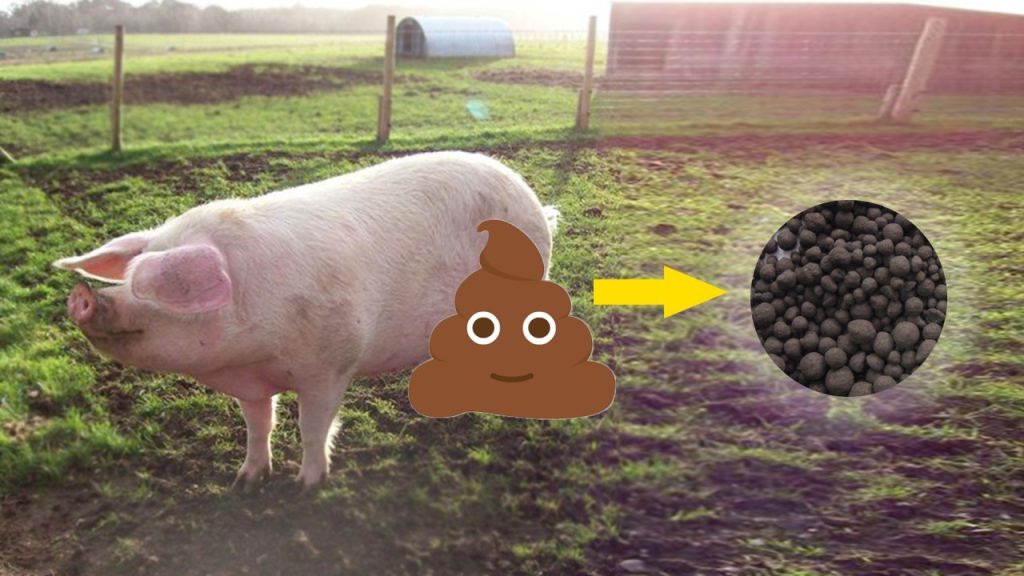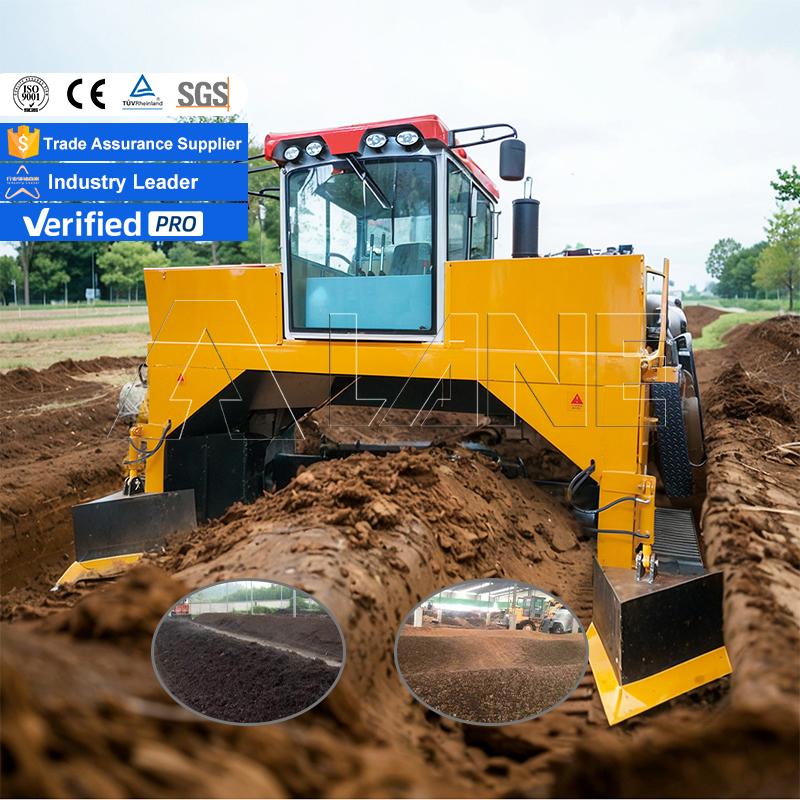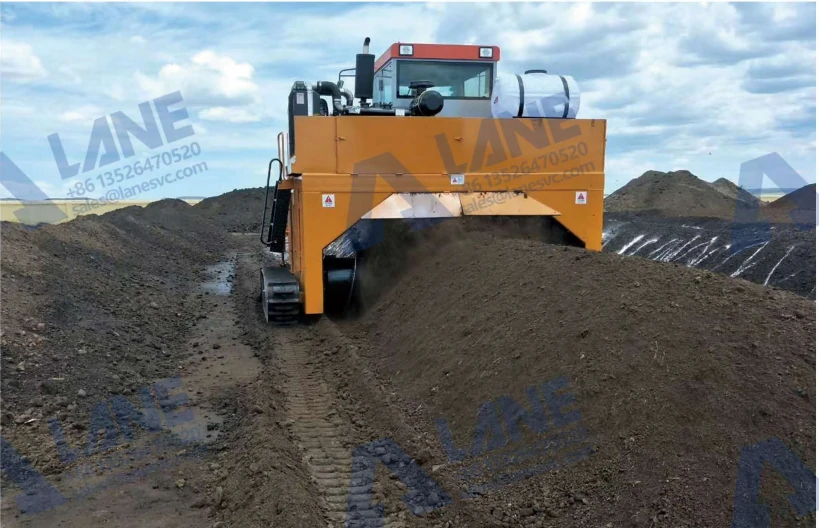Pig manure is a high-quality organic fertilizer, containing a large amount of nitrogen, phosphorus, potassium and other elements, which is of great significance to plant growth and development and the increase of grain crop yield. The general composition of pig manure is: crude organic matter 63.7g/kg, total nitrogen 2.1g/kg, total phosphorus 0.9g/kg, total potassium 1.1g/kg, calcium 1.8g/kg, magnesium 0.7g/kg, sulfur 0.3g/kg, copper 37.6mg/kg, zinc 137.2mg/kg, iron 6.0mg/kg, manganese 425.5mg/kg, boron 9.2mg/kg, molybdenum 1.0mg/kg, etc.
Pig manure composting must be fully decomposed before it can be applied to the soil, otherwise it is easy to burn the roots, and the pests hatched from the eggs in the pig manure will also cause harm to crops. After composting, pig manure can become a high-quality fertilizer mixture, which can be used as a high-quality base fertilizer for plant crops, or it can be sold as a commercial organic fertilizer after subsequent processing.

This fermentation method takes a long time, but the cost is low. The specific method is to mix the pig manure and soil evenly in an environment above 15 degrees, and then cover the manure pile with plastic cloth, which can speed up the fermentation. After a long period of natural decomposition, open the cloth on the manure pile. If steam and white filaments appear at a certain temperature, it means that the fermentation is complete. Then the farmer can transport the pig manure back to the farmland as base fertilizer. However, this composting method does not require the help of a composter, is only suitable for home use, and has a low cost of composting production.
-Long decomposition time (generally 4-6 months), longer time at low temperature, and poor composting fermentation effect.
-Long-term stacking, occupying the site, and polluting the environment.
-The feces after natural composting fermentation are rotten and damp, which is not convenient for direct transportation and utilization.
-Natural composting fermentation cannot effectively eliminate harmful substances such as pathogens and insect eggs, and is easy to cause bacterial infection of plants.
Use small composting equipment to turn the pile and produce high-quality pig manure mixture for fertilization.
Add pig manure fermentation agent during the fermentation process to accelerate the entire fermentation process.
Industrial pig manure composting must be done with the help of a compost turner, which not only ensures the quality of the material turning, but also saves the entire fermentation time and improves work efficiency. In pig manure composting facilities, the most common compost turner is a crawler compost turner.
Mix pig manure with straw, sawdust, and mushroom residue in an appropriate proportion (pig manure accounts for 80%-90%, and the rest accounts for 10%-20%). The ratio is 1t of material (about 2.5t of fresh material) plus 1kg of fermentation agent. After dilution, add 1kg of fermentation agent and 5kg of rice bran (or substitutes such as bran, cornmeal, etc.) into the material pile for mixed fermentation. Before mixing, the strain should be diluted 5 times with some thinner bran powder or cornmeal and other materials to facilitate uniform mixing.
After the strain and diluent are mixed evenly, add them to the pig manure and other materials and mix them evenly. It is best to add straw or mushroom residue to adjust the C:N ratio, which can also avoid uneven nutrients caused by a single material. Common carbon-rich materials include sawdust, sawdust, cassava residue, bagasse, straw powder, peanut shell powder, rice husk powder, cirrus debris, etc. For details, please contact our lane company.
Pig manure composting piles should not be too small or too low. Too small piles are not conducive to fermentation. The fermentation effect of piles with a height of 1.5m-2m, a width of 2m, a length of 10m-20m or larger will be better, and it is also convenient for the compost turner to work. However, different models of compost turners have different requirements for the height and width of the pile.

The starting temperature is at least 15℃ (all year round, not affected by the season, try to ferment indoors or in a greenhouse in winter). Pay attention to the appropriate amount of oxygen supply and turning during the fermentation process, and control the temperature at 55-65℃. Too high a temperature will affect the nutrients. When using livestock and poultry manure as raw material, ammonia will neutralize the organic acid produced by the decomposition of some materials, so 5% phosphate rock powder needs to be added, which is very effective in adjusting the pH value of the material.
The moisture content of pig manure composting materials should be controlled at about 65%. Too high or too low moisture is not conducive to fermentation. Too little moisture will slow the fermentation speed. Too much moisture will cause poor ventilation, slow temperature rise, and odor. The method to adjust the moisture content of the material is: when there is too much moisture, straw, sawdust, mushroom residue, etc. can be added. The method to judge the appropriate moisture content: grab a handful of material with your hand, water marks can be seen, but it does not drip, and the material falls to the ground and scatters.
During the fermentation process, pay attention to oxygenation and turning the compost. Turn the compost when the temperature of pig manure reaches about 60 degrees, turn the compost once a day, and if the temperature exceeds 65 degrees, turn the compost multiple times. Remember, it must be controlled at about 65 degrees. Too high a temperature will affect nutrition.
With the help of a compost turner, pig manure composting generally takes 5-7 days to complete deodorization, compost fermentation, sterilization, etc. Signs of successful pig manure composting: normal compost temperature, loose dark brown material, no original odor, slight ammonia smell, and white mycelium. The finished pig manure organic fertilizer is fluffy, slightly winey or earthy, rich in nutrients, more convenient to use in farmland, and has higher application value in fruits, vegetables, cash crops, flowers and other plants. If too much sawdust, rice husks and other auxiliary materials are added, the fermentation time should be extended to fully compost.

-Food kitchen organic waste (swill) treatment.
-Urban garbage and sludge treatment.
-Industrial organic waste (papermaking sludge, sugar waste, food processing waste, etc.) treatment.
-Agricultural organic waste (chicken manure and livestock and poultry manure, oil cakes, straw, rice husks, Chinese herbal medicine residue, mushroom residue, fermentation products, etc.) treatment.
-Other materials (slaughter residue, sawdust, edible fungus residue, fish manure, biological feed, etc.) treatment. Mixed fertilization with pig manure is an effective way to realize resource utilization, volume reduction and harmless treatment of pig manure, and maturity is an important basis for the design, operation, composting process control and evaluation of compost product quality of organic fertilizer plants.
If you want to know more about pig manure composting technology, please feel free to contact us.